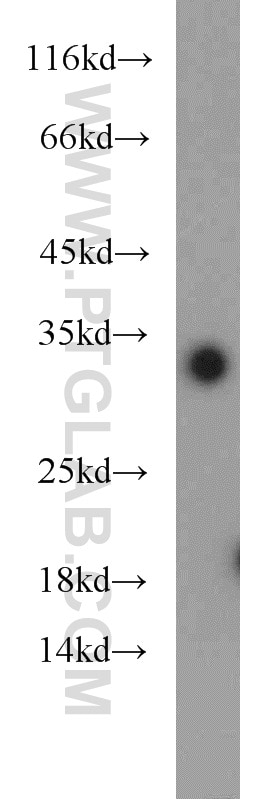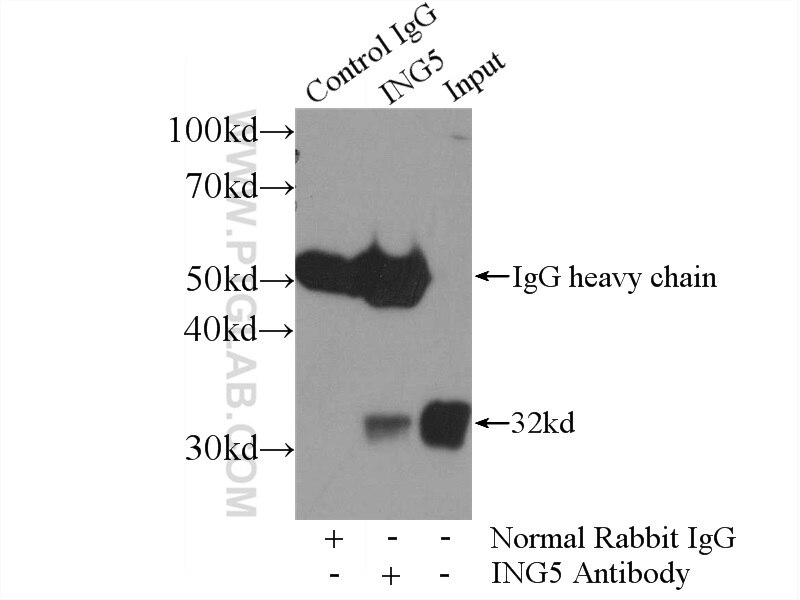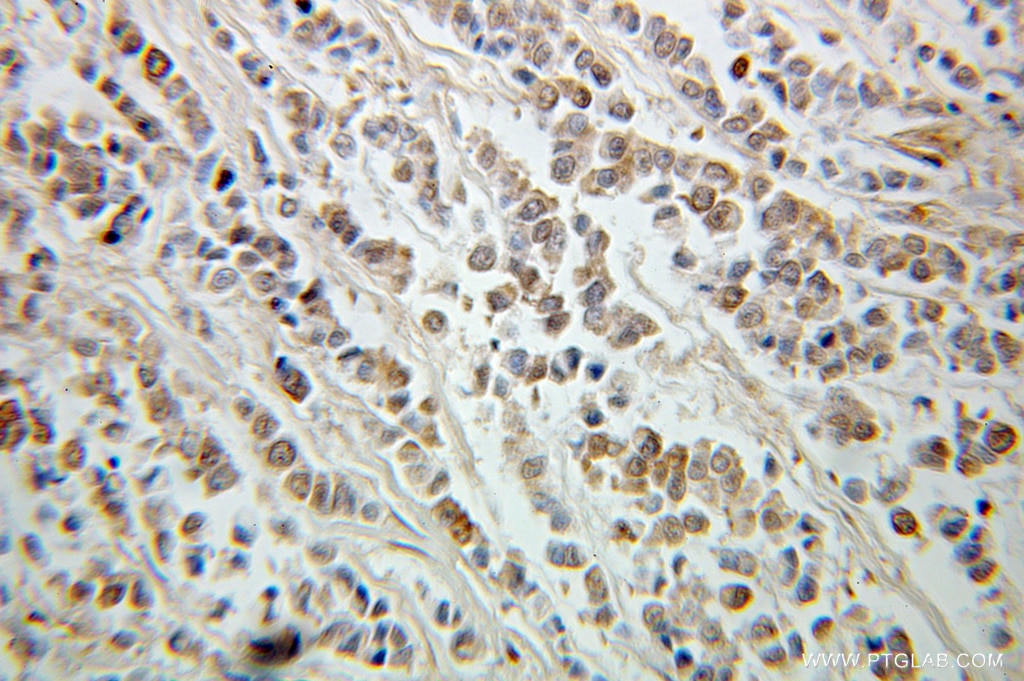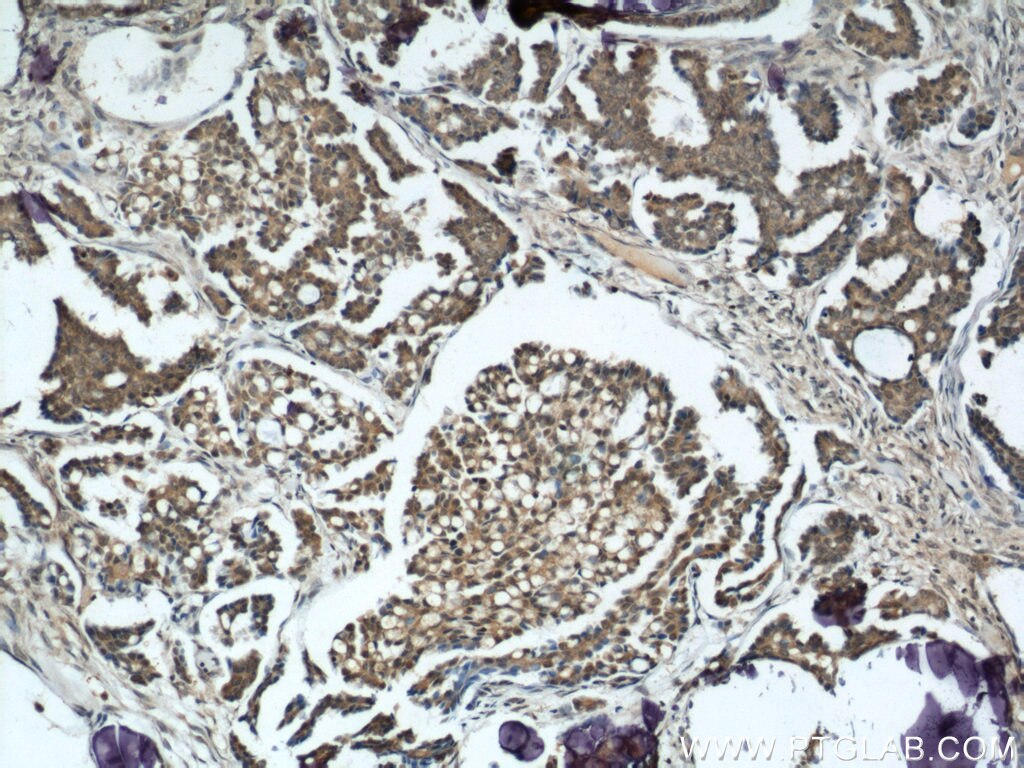- Phare
- Validé par KD/KO
Anticorps Polyclonal de lapin anti-ING5
ING5 Polyclonal Antibody for WB, IP, IHC, ELISA
Hôte / Isotype
Lapin / IgG
Réactivité testée
Humain, rat, souris
Applications
WB, IP, IF, IHC, ELISA
Conjugaison
Non conjugué
N° de cat : 10665-1-AP
Synonymes
Galerie de données de validation
Applications testées
| Résultats positifs en WB | cellules Jurkat, cellules HEK-293, cellules PC-3, tissu rénal de souris |
| Résultats positifs en IP | cellules HEK-293 |
| Résultats positifs en IHC | tissu de cancer du côlon humain, tissu de tumeur ovarienne humain il est suggéré de démasquer l'antigène avec un tampon de TE buffer pH 9.0; (*) À défaut, 'le démasquage de l'antigène peut être 'effectué avec un tampon citrate pH 6,0. |
Dilution recommandée
| Application | Dilution |
|---|---|
| Western Blot (WB) | WB : 1:500-1:1000 |
| Immunoprécipitation (IP) | IP : 0.5-4.0 ug for 1.0-3.0 mg of total protein lysate |
| Immunohistochimie (IHC) | IHC : 1:20-1:200 |
| It is recommended that this reagent should be titrated in each testing system to obtain optimal results. | |
| Sample-dependent, check data in validation data gallery | |
Applications publiées
| KD/KO | See 5 publications below |
| WB | See 20 publications below |
| IHC | See 9 publications below |
| IF | See 4 publications below |
Informations sur le produit
10665-1-AP cible ING5 dans les applications de WB, IP, IF, IHC, ELISA et montre une réactivité avec des échantillons Humain, rat, souris
| Réactivité | Humain, rat, souris |
| Réactivité citée | rat, Humain, souris |
| Hôte / Isotype | Lapin / IgG |
| Clonalité | Polyclonal |
| Type | Anticorps |
| Immunogène | ING5 Protéine recombinante Ag1059 |
| Nom complet | inhibitor of growth family, member 5 |
| Masse moléculaire calculée | 28 kDa |
| Poids moléculaire observé | 28-32 kDa |
| Numéro d’acquisition GenBank | BC005370 |
| Symbole du gène | ING5 |
| Identification du gène (NCBI) | 84289 |
| Conjugaison | Non conjugué |
| Forme | Liquide |
| Méthode de purification | Purification par affinité contre l'antigène |
| Tampon de stockage | PBS avec azoture de sodium à 0,02 % et glycérol à 50 % pH 7,3 |
| Conditions de stockage | Stocker à -20°C. Stable pendant un an après l'expédition. L'aliquotage n'est pas nécessaire pour le stockage à -20oC Les 20ul contiennent 0,1% de BSA. |
Informations générales
ING5, also named as p28ING5, belongs to the ING family. It is a component of the HBO1 complex which has a histone H4-specific acetyltransferase activity, a reduced activity toward histone H3 and is responsible for the bulk of histone H4 acetylation in vivo. ING5 is a component of the MOZ/MORF complex which has a histone H3 acetyltransferase activity. Through chromatin acetylation it may regulate DNA replication and may function as a transcriptional coactivator. (PMID:12750254) Altered ING5 expression and its shift into the cytoplasm may have an impact on the malignant transformation of colorectal epithelial cells and should be considered as a biomarker for colorectal carcinogenesis. (PMID:21193223)
Protocole
| Product Specific Protocols | |
|---|---|
| WB protocol for ING5 antibody 10665-1-AP | Download protocol |
| IHC protocol for ING5 antibody 10665-1-AP | Download protocol |
| IP protocol for ING5 antibody 10665-1-AP | Download protocol |
| Standard Protocols | |
|---|---|
| Click here to view our Standard Protocols |
Publications
| Species | Application | Title |
|---|---|---|
Cell Res LRP6 downregulation promotes cardiomyocyte proliferation and heart regeneration.
| ||
Oncotarget The miR-193a-3p-regulated ING5 gene activates the DNA damage response pathway and inhibits multi-chemoresistance in bladder cancer. | ||
Oncotarget ING5 inhibits cancer aggressiveness via preventing EMT and is a potential prognostic biomarker for lung cancer. | ||
Oncotarget ING5 suppresses proliferation, apoptosis, migration and invasion, and induces autophagy and differentiation of gastric cancer cells: a good marker for carcinogenesis and subsequent progression.
| ||
Oncotarget Upregulated in Hepatitis B virus-associated hepatocellular carcinoma cells, miR-331-3p promotes proliferation of hepatocellular carcinoma cells by targeting ING5.
|











